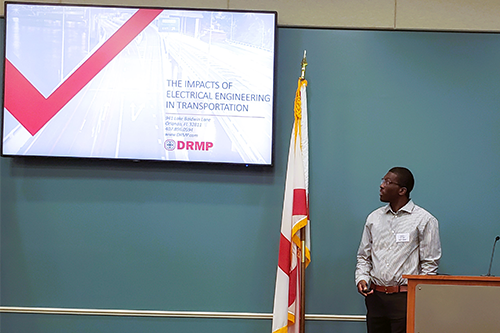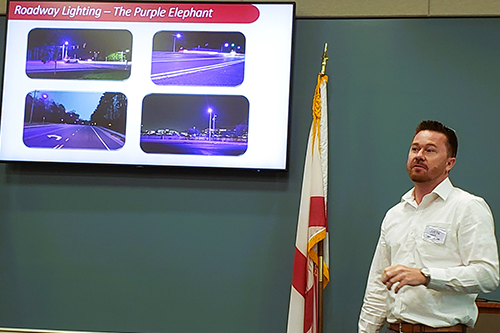As technology becomes more advanced and sophisticated in transportation, a new trend is emerging: the need for electrical engineering. Despite being fewer in number compared to civil engineers, the role of electrical engineers in transportation is becoming more prominent, and DRMP is at the forefront.
The presence of electrical engineers in the transportation sector is not just important, it's crucial. They drive innovation, improve efficiency, enhance safety, and promote sustainability in modern transportation systems. The complexity of traffic systems necessitates their electrical and electronic expertise to operate and maintain system infrastructure and communications.
Consulting firms seek DRMP’s expertise for projects, such as electrical design for wrong-way detection systems and Light-Emitting Diode (LED) roadway lighting conversion. Other companies are enlisting DRMP’s expertise to design charging stations for electric vehicles (EVs) and roadway infrastructure to accommodate autonomous vehicles. This growing demand for electrical engineering signifies a big change in the transportation industry, where these skills are becoming essential.
“Everything is quickly becoming intertwined with technology, and because of that, there’s a large electrical aspect, and the need for electrical engineers is imminent,” said Justin Hayes, EI, a DRMP electrical engineer and Traffic Group Leader and Project Manager in Jacksonville, Fla. “There’s significant re-design that needs to be done in transportation to handle the new technology coming online.”
Hayes and DRMP Traffic Automation Engineer Nigel Atkinson, EI, recently presented, “The Impacts of Electrical Engineering in Transportation," at the monthly meeting of the First Coast Chapter of the Institute of Transportation Engineers (ITE) in Jacksonville.

The key areas of impact they discussed involved:
- Designing electrical systems to power connected vehicle (CV) infrastructure, roadside units (RSUs) capable of communicating to onboard units (OBUs) for autonomous and connected vehicles (a vehicle with the ability to wirelessly link to the internet, road infrastructure, and communicate with other vehicles or pedestrians). An OBU is a hardware device installed within a vehicle that receives and transmits crucial real-time traffic information to enhance road safety and travel times.
-Intelligent Transportation Systems (ITS), including wrong-way detection, tolling detection, and traffic management systems
-Roadway Lighting – converting High-Pressure Sodium (HPS) roadway lighting to LED lighting
-Utility Power Generation, which powers roadway lighting, EV charging infrastructure, traffic control systems, and communication infrastructure, which is essential for emergency services and maintenance operations
Finding electrical engineers for transportation roles can be challenging, as many are drawn to more electrical intensive projects, such as designing electronics or electric vehicles and roadside units, Hayes said.
“In transportation electrical engineering, the focus often shifts to larger industrial projects rather than the intricacies of designing microelectronics, which can feel less stimulating,” Hayes said. “However, with technology rapidly advancing and becoming more integrated, the field is gaining newfound excitement.”
Navigating the Road to Autonomous and Electric Vehicles
The emergence of autonomous vehicles represents a significant development in transportation technology.
Atkinson, who specializes in autonomous vehicle infrastructure design and ITS, has been involved in prior initiatives to establish research and infrastructure for the deployment of automated vehicles.
“The growth of connected-autonomous vehicles is occurring at a fast pace,” Atkinson said. “However, despite this rapid progress, there are still numerous challenges to overcome, including safety concerns and determining the most efficient approach for widespread adoption.”

Progress has been inconsistent but gaining traction, especially since the federal electric vehicle push. There are five levels of autonomy, according to the Society of Automotive Engineers (SAE), Atkinson said.
Level 5 technology, as depicted in the Hollywood film, “I, Robot,” remains distant. Level 4 allows full vehicle autonomy but still requires remote access. Level 4 deployment is nearing, but safety concerns persist. Level 3 needs a driver present.
The trucking industry, for instance, has been conducting trials of autonomous vehicles accompanied by police escorts. In one trial, a driver was required onboard while the vehicle drove autonomously, whereas in another trial, remote control technology was used to drive the vehicle alongside a police escort, Hayes said.

Hayes and Atkinson discussed electric vehicles and how they've evolved over time due to advancements in vehicle technology and electrical engineering.
“Despite being around since 1832, many people view them as modern innovations,” Atkinson said. “However, electric vehicles have been competing with gas vehicles since the beginning, although gas vehicles advanced faster. With concerns over climate change and gas prices, EVs are becoming much more essential and more of a priority.”
There also was considerable discussion about the state of electric charging infrastructure. One question raised was whether local and state agencies will be adequately equipped to oversee such projects, install, and sustain charging stations.
“With numerous federal initiatives pushing grant funding for these projects, there are a lot of requirements for eligibility,” Atkinson said. “Do agencies have the staff and knowledge base to install and maintain these stations? One approach has been identified through Public Private Partnerships (PPP) and seeking specialized services from a consultant like DRMP for such tasks.”
'The Purple Elephant in the Room'
The significance of electric utilities in supporting intelligent transportation infrastructure cannot be overstated. Therefore, it is crucial to implement contingency measures, as evidenced by a recent incident of a manufacturing flaw in roadway lighting. This flaw resulted in widespread purple roadway lighting across the state of Florida and the entire nation.

“Despite limited information, I investigated and uncovered what could be the root cause,” Hayes said. “I called it, ‘The Purple Elephant in the Room.’ These lights function using three different LEDs to generate white light. However, an error occurred when the electrical circuit for the green LED used the same size resistor as the circuit for the red LED.
“The green LED circuit is required to use the same resistor as the blue LED circuit,” Hayes continued. “This resulted in reduced production of green light, emitting primarily red and blue light, which combined, produces purple.”
Hayes and Atkinson also addressed the importance of power utilities in the transportation network, highlighting the need for backup plans in case of outages. In the state of Florida, most maintaining agencies require backup power sources, such as generators or batteries to keep critical infrastructure running during outages.
DRMP assists in designing and sizing Uninterruptible Power Supply (UPS) systems for various roadway devices and collaborates with utilities to ensure power requirements are met, as power outages can disrupt the entire system.
“When implementing new infrastructure, having backup plans is essential, and we handle the design aspect to ensure resilience,” Hayes said.
The role of electrical engineers in transportation is vital to integrating new roadway technology to promote safety and sustainability. As technology evolves and increases in sophistication, the role of electrical engineers in the Transportation Market Sector will become paramount.
Justin E. Hayes, EI, serves as the Jacksonville Traffic Group Leader and a Project Manager for DRMP’s Transportation Market Sector.


















